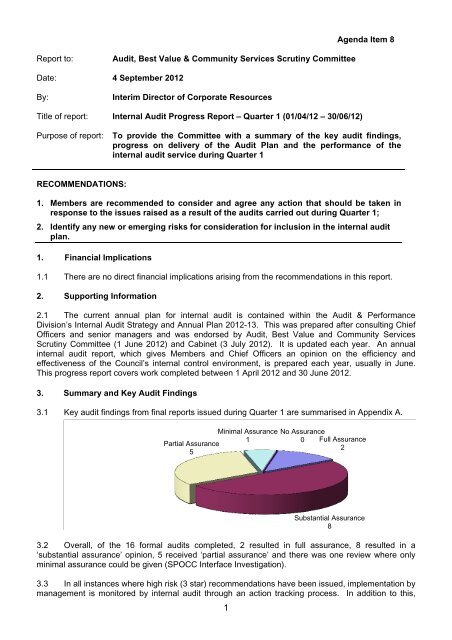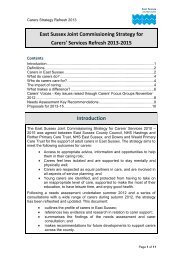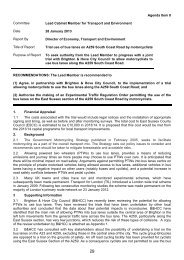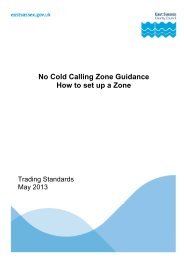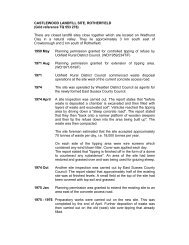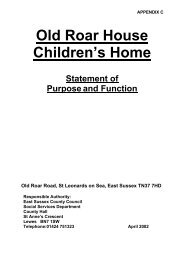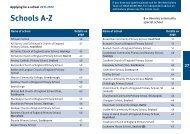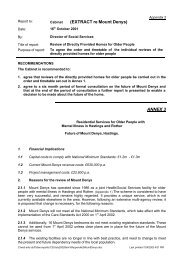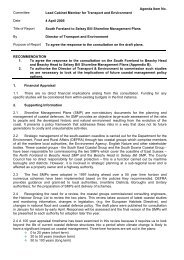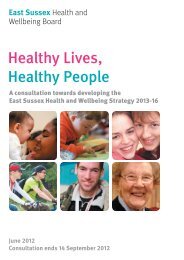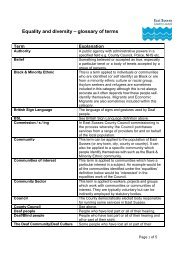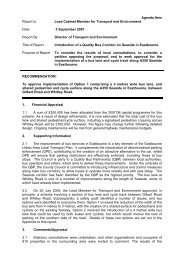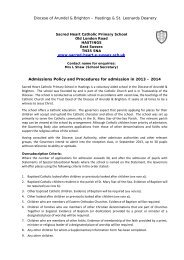Item 8 - Internal Audit Progress Report - East Sussex County Council
Item 8 - Internal Audit Progress Report - East Sussex County Council
Item 8 - Internal Audit Progress Report - East Sussex County Council
You also want an ePaper? Increase the reach of your titles
YUMPU automatically turns print PDFs into web optimized ePapers that Google loves.
<strong>Report</strong> to: <strong>Audit</strong>, Best Value & Community Services Scrutiny Committee<br />
Date: 4 September 2012<br />
By: Interim Director of Corporate Resources<br />
Title of report: <strong>Internal</strong> <strong>Audit</strong> <strong>Progress</strong> <strong>Report</strong> – Quarter 1 (01/04/12 – 30/06/12)<br />
Purpose of report:<br />
RECOMMENDATIONS:<br />
Agenda <strong>Item</strong> 8<br />
To provide the Committee with a summary of the key audit findings,<br />
progress on delivery of the <strong>Audit</strong> Plan and the performance of the<br />
internal audit service during Quarter 1<br />
1. Members are recommended to consider and agree any action that should be taken in<br />
response to the issues raised as a result of the audits carried out during Quarter 1;<br />
2. Identify any new or emerging risks for consideration for inclusion in the internal audit<br />
plan.<br />
1. Financial Implications<br />
1.1 There are no direct financial implications arising from the recommendations in this report.<br />
2. Supporting Information<br />
2.1 The current annual plan for internal audit is contained within the <strong>Audit</strong> & Performance<br />
Division’s <strong>Internal</strong> <strong>Audit</strong> Strategy and Annual Plan 2012-13. This was prepared after consulting Chief<br />
Officers and senior managers and was endorsed by <strong>Audit</strong>, Best Value and Community Services<br />
Scrutiny Committee (1 June 2012) and Cabinet (3 July 2012). It is updated each year. An annual<br />
internal audit report, which gives Members and Chief Officers an opinion on the efficiency and<br />
effectiveness of the <strong>Council</strong>’s internal control environment, is prepared each year, usually in June.<br />
This progress report covers work completed between 1 April 2012 and 30 June 2012.<br />
3. Summary and Key <strong>Audit</strong> Findings<br />
3.1 Key audit findings from final reports issued during Quarter 1 are summarised in Appendix A.<br />
Partial Assurance<br />
5<br />
Minimal Assurance<br />
1<br />
No Assurance<br />
0 Full Assurance<br />
2<br />
Substantial Assurance<br />
8<br />
3.2 Overall, of the 16 formal audits completed, 2 resulted in full assurance, 8 resulted in a<br />
‘substantial assurance’ opinion, 5 received ‘partial assurance’ and there was one review where only<br />
minimal assurance could be given (SPOCC Interface Investigation).<br />
3.3 In all instances where high risk (3 star) recommendations have been issued, implementation by<br />
management is monitored by internal audit through an action tracking process. In addition to this,<br />
1
formal follow up reviews will be undertaken in relation to all fundamental accounting systems, all audits<br />
with either ‘minimal’ or ‘no assurance’ and a number of the audits with ‘partial assurance’.<br />
3.4 As well as conducting formal follow up reviews in all cases where an audit opinion of either<br />
‘minimal’ or ‘no assurance’ has been given, we have in place arrangements to track the<br />
implementation of all high risk audit recommendations issued during the year. The position relating to<br />
those high risk recommendations issued in the 12 months to 30 June 2012 is shown in the following<br />
graph:<br />
3.5 Of the 3 recommendations where implementation is overdue, in one case the recommendation<br />
has now been implemented, and in the remaining two cases implementation of the recommendation is<br />
imminent. We will continue to monitor progress and escalate with management where we believe this<br />
exposes the <strong>Council</strong> to any unacceptable risk. Further details are provided in Appendix B.<br />
3.6 Member’s attention is also drawn to our work on: Concessionary Fares (p10); Galaxy (p11/12);<br />
ContrOCC / Abacus (p 6); Youth Offending Team (p7/8).<br />
3.7 In addition to the individual audit reports, annual reports and opinions were produced and<br />
presented during the quarter for the <strong>County</strong> <strong>Council</strong> as a whole and separately for each department.<br />
In each case the opinion was satisfactory. <strong>Internal</strong> audit also contributed to the preparation of the<br />
<strong>Council</strong>’s Annual Governance Statement for 2011/12.<br />
3.8 Members will recall that flexibility was built into the audit plan to allow resources to be directed<br />
to new and emerging risks during the year. We continue to liaise with departments to identify these<br />
but would also welcome input from this Committee.<br />
4 Performance against targets<br />
4.1 As agreed as part of the recent service review, a revised set of performance measures for<br />
<strong>Internal</strong> <strong>Audit</strong> have been developed for 2012/13 focussing on: quality / customer satisfaction;<br />
compliance with professional standards; and cost / coverage. All targets are currently assessed as on<br />
target (Green) apart from post audit questionnaire responses that are currently running at 88% just<br />
below target. Full details of performance indicators in shown in Appendix C.<br />
ANDREW TRAVERS<br />
Interim Director of Corporate Resources<br />
Contact Officers: Duncan Savage Tel No. 01273 482330<br />
Russell Banks Tel No. 01273 481447<br />
Local Member: All<br />
BACKGROUND DOCUMENTS - <strong>Internal</strong> <strong>Audit</strong> Strategy and Annual Plan 2012-13<br />
2
Summary of key audit findings<br />
Pension Fund Governance & Strategy (Corporate Resources Directorate)<br />
3<br />
Appendix A<br />
This report is part of the agreed <strong>Audit</strong> Strategy for the <strong>East</strong> <strong>Sussex</strong> Pension Fund (the Fund) and<br />
draws on all the audits carried out as part of that strategy during the year. <strong>East</strong> <strong>Sussex</strong> <strong>County</strong><br />
<strong>Council</strong> has a statutory responsibility to administer and manage the Fund on behalf of a range of<br />
public bodies.<br />
The key control objectives of this audit were:<br />
There is a statement of objectives for the Fund which is linked to measurable targets and<br />
performance indicators.<br />
There are comprehensive risk management arrangements in place for the Pension Fund.<br />
The investment strategy is appropriate and strategy decisions are implemented correctly and in<br />
a timely manner.<br />
Management information systems provide assurance that Fund assets are invested in<br />
accordance with the investment strategy<br />
Adequate reporting and monitoring arrangements are in place to monitor he performance of<br />
external advisors and service providers.<br />
The Fund assets are sufficient to meet its obligations and liabilities.<br />
All accounting records and statements are in accordance with the prevailing accounting<br />
standards and good practice.<br />
The Fund is administered in accordance with best practice and legislative requirements.<br />
The Fund Administrators communicate effectively and promptly with all stakeholders.<br />
On the basis of the internal audit work completed we provided a full assurance opinion on the<br />
framework of control. A number of recommendations were made to further improve controls and these<br />
have been agreed by management.<br />
<strong>County</strong> Hall Cash Security (Corporate Resources Directorate)<br />
During quarter 1, <strong>Internal</strong> <strong>Audit</strong> undertook an exercise to review the security of cash held at <strong>County</strong><br />
Hall Main Reception. This unplanned review identified a number of opportunities to improve security<br />
and control, all of which were agreed with facilities management staff and all but one had been<br />
implemented by June 2012.<br />
SAP Generic Controls (Corporate Resources Directorate)<br />
The <strong>Council</strong> has implemented SAP as its key system for financial management, budgeting and<br />
reporting functions, as well as payments to employees, suppliers and billing of revenue. Many of the<br />
ICT controls within the SAP environment are common to a number of the individual SAP component<br />
applications (e.g. Accounts Payable (AP), Accounts Receivable (AR), Procurement and HR/Payroll).<br />
Key controls in the following areas were reviewed:<br />
Access Controls<br />
Data Input<br />
Data Processing and Interface Controls<br />
Output Controls<br />
Management Trails<br />
Backup and Recovery<br />
System Enhancements and Development<br />
Support Arrangements<br />
Based on the audit work completed an overall opinion of substantial assurance was provided over<br />
the control environment. Three medium risk recommendations for improvement in access controls,
incident reporting and application / interface controls have been agreed with ICT Services<br />
Management:<br />
Oracle Database Controls (Corporate Resources Directorate)<br />
The Oracle Database, also known as an object relational database management system (RDBMS), is<br />
the primary data storage repository of the <strong>Council</strong>’s Oracle based business systems which include:<br />
The Social Services Client System (OLM Carefirst);<br />
Financial Services Enterprise Management System (SAP);<br />
The Transport and Environment Department Infrastructure Asset Management System (Bentley<br />
EXOR); and<br />
The Transport and Environment Department Property Gazetteer System (Aligned Assets –<br />
Symphony Suite).<br />
The Carefirst, Exor and Symphony system Oracle databases are hosted at the ESCC data centre and<br />
the SAP Oracle Database is hosted by Serco at their Birmingham Data centre.<br />
Key controls in the following areas were reviewed:<br />
Governance, accountability, roles and responsibilities<br />
Risk and configuration management<br />
Logical security (Benchmarking the use of controls to the best practice standards and alerts)<br />
Database management indexing and archiving procedures.<br />
The scope of the audit was limited due to the fact that some contracts did not have 3 rd party audit<br />
access rights included and this has contributed to the provision of a partial assurance opinion. Three<br />
medium risk recommendations have been agreed with ICT Services Management to address the<br />
access issue along with improvements to monitoring of database KPIs and patch management.<br />
Public Sector Network (Corporate Resources Directorate)<br />
The <strong>Council</strong> is engaged jointly with Brighton and Hove City <strong>Council</strong> in a project to deliver a Public<br />
Sector Network. This requires the procurement and provision of a variety of services, including Local<br />
Area Network and telephony, to a number of Public Sector stakeholders (“The Consortium”).<br />
<strong>Internal</strong> audit has conducted an initial review and provided advice to the project team in relation to:<br />
Governance and risk management arrangements;<br />
Stakeholder involvement and responsibilities;<br />
Compliance with procurement framework requirements;<br />
On-going supplier management, and;<br />
Management arrangements for the different security accreditation requirements within the<br />
Consortium.<br />
To date, some specific recommendations on risk management arrangements for the project and the<br />
need to ensure full representation of all stakeholder bodies within the project governance framework<br />
have been made. These recommendations have all been accepted by the Project Assurance Board.<br />
Our work on this project will continue throughout the coming year with further updates to be provided.<br />
Purchasing Cards (Corporate Resources Directorate)<br />
Since June 2010, ESCC have operated a purchasing (debit) card scheme, whereby approved staff<br />
use a P-Card to purchase goods and services, rather than a conventional purchase order and invoice,<br />
4
or by using petty cash. By May 2012 the number of active card holders had risen to 212 and monthly<br />
transaction levels to £115,000.<br />
The key control objectives of this audit were to ensure that:<br />
Cards are only issued to appropriately authorised staff.<br />
All expenditure incurred is accurately recorded, VAT is correctly accounted for and receipts are<br />
acquired accordingly.<br />
Purchasing cards are used only for goods and services wholly, exclusively and necessarily for<br />
the use of the <strong>Council</strong>, and for the best value attainable.<br />
P-Card policy is robust and is communicated to all cardholders and reviewers.<br />
Cardholders and card reviewers fulfil their responsibilities in accordance with up to date card<br />
policy and guidance.<br />
The resources expended in the administration processes governing cards are efficient and<br />
proportionate.<br />
There are proper controls in place for embedded card schemes to prevent anyone other than<br />
nominated staff from placing orders.<br />
No major weaknesses were identified and the majority of transactions tested were found to have been<br />
completed and reviewed satisfactorily leading to an overall opinion of substantial assurance. A small<br />
number of medium and low risk recommendations were made to improve controls over reviewing of<br />
transactions, training and VAT compliance. All recommendations have been agreed with<br />
management and are due to be implemented before the end of August 2012.<br />
Integrated Community Equipment Services (ICES) (Adult Social Care)<br />
The ICES was established in <strong>East</strong> <strong>Sussex</strong> in September 2004 and a Section 75 Pooled Budget<br />
agreement commenced for the service in April 2007. Since this time, joint eligibility criteria have been<br />
in place across health and social care within adult services.<br />
The key control objectives of this audit were to ensure that:<br />
Adequate controls exist over the ICES ordering process;<br />
Adequate controls exist in the ICES payment process, including the goods receipting;<br />
The Pooled Budget arrangement is managed effectively and the aims of the agreement are<br />
achieved;<br />
Accurate, appropriate and timely management information is available for budget and performance<br />
monitoring and is regularly reviewed.<br />
Overall, no major weaknesses were identified within the ICES system with an opinion of substantial<br />
assurance therefore being provided over the control environment. Adequate arrangements are in<br />
place to monitor the pooled budget and where variations are identified, these are raised with the ICES<br />
Commissioning Board as they occur.<br />
Some opportunities to further strengthen controls were identified, primarily in relation to improving the<br />
management of user access to the provider ordering system. All recommendations have been agreed<br />
with management.<br />
Resource Allocation System (RAS) (Adult Social Care)<br />
The main purpose of the audit was to give an opinion on whether the RAS is accurate, fit for purpose<br />
and has been properly tested. Assurance was also sought that adequate controls are in place to<br />
ensure that the RAS is fully integrated into the ASC IT infrastructure.<br />
The RAS is a calculator that determines how much money is allocated to a personal budget, based on<br />
points scored provided from information obtained during the assessment process. It has been<br />
developed following the Green Paper “Shaping the Future of Care Together” which suggests that care<br />
and support needs are calculated in the same way throughout England.<br />
5
The purpose of the RAS is to distribute resources to individuals in a fair and equitable way and it<br />
attempts to do this by applying a weighting (points) to a number of questions about the person’s<br />
needs. An allocation of funds is then given per point.<br />
The key control objectives of this audit were:<br />
Adequate contractual arrangements are in place between ESCC and FACE Recording &<br />
Measurement Systems who have been engaged to develop the RAS on behalf of ESCC.<br />
The RAS models are fit for purpose and calculate accurate values of support packages.<br />
All RAS models are tested continuously and updated with all learning, risks and issues identified.<br />
Updated documentation and procedures are available, including comprehensive procedure<br />
notes.<br />
Based on the audit work completed we were able to provide substantial assurance over the<br />
framework of control. We made one recommendation regarding the signing of a contract with the RAS<br />
supplier, FACE, which is yet to be finalised although the <strong>Council</strong> has been working with the supplier<br />
since 2008/09. Management anticipate the contract will now be signed by end of August 2012.<br />
ContrOCC / Abacus (Adult Social Care)<br />
ContrOCC / Abacus is a fundamental accounting system and this review is relied upon by the external<br />
auditors in forming an opinion on the <strong>County</strong> <strong>Council</strong>’s accounts.<br />
ContrOCC is used to record contractual obligations and control payments to independent sector<br />
suppliers of day care, home care, residential and nursing care services. In addition, Abacus is still<br />
used for a number of payment and income streams (e.g. transport payments).<br />
Clients in receipt of home care, day care, residential and nursing care services, depending on their<br />
Financial Assessment, are required to contribute towards the cost of services. For clients paying<br />
standard weekly contributions by direct debit, invoices are raised through SAP via an interface with<br />
ContrOCC. Until recently, invoices for day-care/homecare, supported accommodation, standard<br />
weekly contributions (giro), gross residential and property were raised through a manual billing<br />
process. ContrOCC billing for these areas went live in February 2012.<br />
Between April and January 2012, £9.9m payments were made through Abacus and £109.5m through<br />
ContrOCC. For the same period, £3.07m of income was received through Abacus, £19.5m through<br />
ContrOCC and £19.3m through the manual billing process.<br />
Abacus was due to be de-commissioned at the end of 2010/11, but was still used in 2011/12. The<br />
majority of payments have now been migrated to ContrOCC, and an exercise is underway to transfer<br />
the remainder.<br />
The following control objectives were covered as part of the review:<br />
All payments made are accurate, timely, legitimate and properly authorised<br />
Adequate interface controls exist between the source systems (ContrOCC / Abacus) and SAP<br />
Access to the system is secure and data held is protected against loss or damage.<br />
All services provided are accurately invoiced on a timely basis<br />
The financial assessment process is robust and results in an accurate and timely assessment of<br />
a client’s ability to contribute towards services provided<br />
Credit notes/invoice amendments / write-offs are properly authorised<br />
The audit opinion has reduced since 2010/11 to partial assurance primarily as a result of<br />
deterioration in the control environment following the transition from Abacus to ContrOCC.<br />
Management are aware of these issues and are liaising with Oxford Computer Consultants (the<br />
providers of ContrOCC) to improve them. The main areas where improvements are required cover:<br />
reconciliations between ContrOCC and SAP; storage of processed invoices; testing of systems<br />
upgrades prior to implementation in a live environment and; monitoring of users with systems admin<br />
rights within ContrOCC. A management action plan covering these areas has been agreed with<br />
management.<br />
6
SPOCC Interface Investigation (Adult Social Care)<br />
SPOCC is the Supporting People IT system used by Adult Social Care. Payments are made two<br />
weeks in arrears and two weeks in advance every 28 days to approximately 45 providers for<br />
c£900,000.<br />
Following an incident where a duplicate payment was exported from SPOCC into SAP, but which was<br />
subsequently rejected, Adult Social Care requested an audit review of the controls over the<br />
SPOCC/SAP interface.<br />
It is our opinion that the duplicate file transfer on 3 rd April 2012 occurred as a result of the failure to<br />
‘finalise’ the correct payment file and also the failure to undertake proper verification in accordance<br />
with established procedures. This resulted in the payment file for the previous period, being the most<br />
recently ‘finalised’ file, being processed a second time.<br />
As part of this investigation, we have identified a number of potentially serious control weaknesses<br />
within in the SPOCC system and associated with the interface to SAP and have therefore only been<br />
able to provide minimal assurance over the control environment. We have made a number of<br />
recommendations for improvements to the configuration of the SPOCC system, validation and<br />
reconciliation procedures and guidance to staff and these need to be addressed urgently to ensure<br />
controls are in place to prevent duplicate or erroneous payments in the future. A management action<br />
plan was agreed and all the recommendations were due to be implemented by the end of May.<br />
However, as noted in paragraph 3.5 of the main report, implementation of two of these<br />
recommendations is dependent upon reconfiguration of the system by the software providers, and<br />
they have now committed to providing the solution later in July 2012. Management will then test it,<br />
and incorporate it into the live environment by the end of August 2012. A number of lower risk<br />
recommendations are in the process of being implemented.<br />
Youth Offending Team (Children’s Services)<br />
The main purpose of the audit was to assess whether adequate and robust financial systems and<br />
controls are in place and to seek assurance that sensitive data is adequately protected. This follows<br />
notification of two recent incidents. One involved the theft of petty cash from the Hastings office, which<br />
has been the subject of a separate investigation, and the second involved an allegation of mileage<br />
claims being inflated by a volunteer working for a third party organisation. The review did not cover the<br />
actual provision of ‘Youth Offending’ services.<br />
The review covered the following control objectives:<br />
Budgetary monitoring and control is adequate, effective and timely.<br />
Adequate arrangements are made to safeguard the security of cash, and equipment.<br />
Appropriate security arrangements are in place to protect sensitive information.<br />
Payments to staff or, where appropriate, to volunteers are only made for hours actually worked /<br />
expenses actually incurred and all additional hours are properly authorised.<br />
Appropriate checks are carried out before staff or volunteers are assigned to cases.<br />
Contractual arrangements with third party agencies are robust and adequately monitored and<br />
controlled.<br />
Based on the audit work undertaken we were able to provide partial assurance over the control<br />
framework. The key areas for improvement related to:<br />
Client information is stored in the Youth Offending Information System (YOIS) database and we<br />
found these database access controls to be weak.<br />
Sensitive client information is being saved in unprotected spreadsheets in team network folders<br />
and that network access controls are inadequate to prevent unauthorised access to the data.<br />
During the calendar year 2011, payments of £117,000 were made to a voluntary organisation<br />
commissioned to provide youth offending services. The service has not been able to supply any<br />
supporting documentation to confirm the accuracy of these payments. In addition, 2 of the 3<br />
7
service level agreements could not be located and we were therefore unable to confirm that the<br />
terms and conditions of payment had been met. The contract has reached its end date since the<br />
audit was conducted.<br />
All recommendations arising from the review have been agreed with management as part of a formal<br />
action plan which will be subject to follow up at a future date.<br />
Schools On-Line Payment System (Children’s Services)<br />
There is a range of competing online payment systems on the market, the majority of which offer<br />
similar functionality, allowing parents to make payments for a variety of items including school meals,<br />
uniform and trips. One of these, ParentPay, is already being used as part of the school meals contract<br />
with Chartwells, and consideration is now being given to allowing schools within this contract to use<br />
ParentPay for other types of income, at no additional cost, subject to adequate controls being in place.<br />
The following control objectives were covered:<br />
Adequate arrangements are put in place to ensure that schools implement robust on-line income<br />
collection systems.<br />
All income collected via online income systems is accurately, promptly and completely recorded.<br />
Systems are adequately secured and controlled to prevent data loss, falsification of records or<br />
misuse.<br />
Whilst we have been able to provide substantial assurance over controls associated with the use of<br />
online payment facilities, we have identified some weaknesses in the systems in operation and these<br />
are reported below.<br />
Prior to beginning this work, it was clear that some schools had already implemented online<br />
payment systems without consulting the Director of Corporate Resources, as required within<br />
ESCC Financial Regulations for Schools and Colleges.<br />
Apart from the schools using ParentPay as part of the formal school meals contract with<br />
Chartwells, no other schools had a signed written contract with their online payments provider,<br />
covering the terms and conditions and obligations of both parties.<br />
Very few schools had tested the payment facilities prior to their implementation.<br />
Few schools had considered the need to tailor user’s access dependant on their roles and<br />
responsibilities, increasing the risk of error or data manipulation.<br />
Reconciliations of payments received from parents to entries on schools’ bank accounts are not<br />
always taking place.<br />
The guidance developed by Children’s Services on the procurement and implementation of<br />
online payment systems and issued in November 2011 needs to be revised to reflect the audit<br />
findings.<br />
A comprehensive action plan has been agreed with Children’s Services Management and will involve<br />
guidance to schools being revised and re-publicised.<br />
Sixth Form Funding (Children’s Services)<br />
In September 2010, the Young People’s Learning Agency (YPLA) issued guidance for local authorities<br />
on gaining assurance over the funding paid in respect of local authority maintained schools with sixth<br />
forms from 1 st April 2010.<br />
Whilst it is not a mandatory requirement to adhere to this guidance, the YPLA and Skills Funding<br />
Agency (SFA) Joint <strong>Audit</strong> Code of Practice says that local authorities will give assurance through their<br />
Chief Financial Officer’s (CFO) annual grant return to the YPLA over funds paid to them by the SFA<br />
and YPLA, i.e. the CFO will be required to certify that the funding provided is an accurate reflection of<br />
each school’s circumstances. This covers the periods 1 April 2011 to 31 July 2011, and 1 August 2011<br />
to 31 March 2012. The grant return for both of these periods is required to be submitted to the YPLA<br />
by 30 April 2012.<br />
8
ESCC currently has seven secondary schools with sixth forms. Following on from our pilot review of<br />
Heathfield Community College last year, in 2011/12 we reviewed Beacon, Uplands and Hailsham<br />
Community Colleges<br />
On the basis of the limited work we have carried out, we have not found any evidence that indicates<br />
that the funds provided by the SFA and the YPLA to the local authority have not, in all material<br />
respects, been used for the purposes intended by those funding bodies and in accordance with their<br />
terms and conditions of funding. A number of minor anomalies identified from the samples tested have<br />
been notified to the YPLA and it’s successor body the Education Funding Agency (EFA). The YPLA<br />
advised that it would not make any changes to the funding received as a result and we are awaiting a<br />
response from the EFA.<br />
Exor Application review (Economy, Transport and Environment)<br />
The Exor application is the corporate highways management system used by the services in the<br />
Economy, Transport and Environment Department (ETE) at <strong>East</strong> <strong>Sussex</strong> <strong>County</strong> <strong>Council</strong> for the<br />
administration, processing and management of highways construction, repairs, engineering and<br />
maintenance service provisions to the <strong>Council</strong>. Currently, the main contractor with the <strong>Council</strong> is May<br />
Gurney Limited who receives work orders totalling approximately £15m per year, through Exor.<br />
Key controls in the following areas were reviewed:<br />
Access Controls<br />
Data Input<br />
Data Processing and Interface Controls<br />
Output Controls<br />
Management Trails<br />
Backup and Recovery<br />
System Enhancements and Development<br />
Support Arrangements<br />
Based on the audit work completed an overall opinion of substantial assurance was provided over<br />
the control environment. Recommendations for improvement were made in regard to access controls,<br />
monitoring and reporting of access violations, user account creation and monitoring and have been<br />
agreed with ETE and ICT Services Management.<br />
<strong>Sussex</strong> Safer Road Partnership (SSRP) (Economy, Transport and Environment)<br />
The <strong>Sussex</strong> Safer Road Partnership (SSRP) is a local government initiative which evolved out of the<br />
<strong>Sussex</strong> Camera Partnership in 2007 following government changes to the funding. The core activity<br />
of the SSRP is to reduce road casualties across <strong>Sussex</strong>.<br />
The Partnership is funded by three local highway authorities (West and <strong>East</strong> <strong>Sussex</strong> <strong>County</strong> <strong>Council</strong>,<br />
and Brighton and Hove City <strong>Council</strong>) and <strong>Sussex</strong> Police who have invested surplus funds, obtained<br />
from providing speed awareness courses. Other members of the partnership are West and <strong>East</strong><br />
<strong>Sussex</strong> Fire and Rescue Services, and the Highways Agency.<br />
The key control objectives of this audit were to ensure that:<br />
Partnership governance arrangements are robust and in line with best practice and legislative<br />
requirements;<br />
Adequate reporting and performance monitoring arrangements are in place that enables informed<br />
decision-making;<br />
Funding contributions are fairly calculated and properly communicated and received to ensure the<br />
objectives of the SSRP are met, and funds are spent in accordance with agreed objectives;<br />
Budget management is adequate and effective;<br />
Adequate links exist with other local safety initiatives to help ensure effective partnership working<br />
and to avoid duplication of effort.<br />
9
Based on the audit work undertaken, we were able to provide substantial assurance over the control<br />
framework, with only a small number of recommendations for improvement being made. These relate<br />
primarily to strengthening risk management arrangements and ensuring that all committees/groups<br />
have formal terms of reference. All recommendations have been agreed with management and are<br />
due to be implemented before the end of July 2012.<br />
Concessionary Fares Scheme (Economy, Transport and Environment)<br />
The responsibility for administering the concessionary fare scheme passed to ESCC on 1 April 2011.<br />
This was therefore the first audit of the system. As well as reimbursements for journeys starting in<br />
<strong>East</strong> <strong>Sussex</strong>, ESCC also pays reimbursements in respect of West <strong>Sussex</strong> <strong>County</strong> <strong>Council</strong>, which it<br />
then recharges. An administration fee is also charged for providing this service. The overall budget<br />
for the concessionary fare scheme is £7.091m. The expected out-turn for 2011/12 is £7.424m, which,<br />
with the central government grant of £5.88m, will result in a net cost to ESCC of £1.544m<br />
ESCC has engaged The Martlet Consultancy Ltd (MCL), a company specialising in concessionary fare<br />
administration, to liaise with bus operators and to make the calculations that determine the amounts<br />
due to be reimbursed to each bus operator.<br />
The purpose of the audit was to provide assurance to management that the systems and controls are<br />
adequate and operating effectively, focussing on the following control objectives:<br />
the Concessionary Travel Scheme is administered in accordance with at least minimum statutory<br />
requirements;<br />
payments are only made to bus operators who provide genuine and accurate claims for<br />
reimbursement;<br />
adequate reporting and performance monitoring arrangements are in place to monitor contractor<br />
(MCL) performance;<br />
travel concession passes are only issued to people who meet the criteria set out in the legislation<br />
for the statutory minimum concession or any additional discretionary criteria agreed by the <strong>Council</strong>;<br />
there are robust mechanisms in place to prevent and detect the abuse of the travel concession<br />
scheme;<br />
budget management is adequate and effective; and<br />
a risk management model is in place and structured to identify and manage key risks associated<br />
with the concessionary travel scheme.<br />
Overall, we have been able to provide partial assurance over the control environment. The key<br />
areas for improvement related to:<br />
Access controls for the Faredeal system (the database of card holders), particularly for staff within<br />
Libraries. Control over privileged access to the system also required strengthening;<br />
Management and monitoring of the contract with MCL Ltd and clarifying roles and responsibilities<br />
between ESCC and the contractor;<br />
Arrangements for validating the accuracy of invoices prior to payment;<br />
Ensuring that a full and complete audit trail of applications forms is maintained in order to support<br />
all concessionary passes awarded.<br />
This is a new service provided by ESCC and many of the weaknesses identified relate to the relative<br />
infancy of ESCC responsibility. All recommendations arising from the review have been agreed with<br />
management as part of a formal action plan which will be subject to follow up at a future date.<br />
Parking Enforcement Contract KPI's (Economy, Transport and Environment)<br />
A new parking enforcement contract started in September 2011. Within the terms of the contract is a<br />
performance-related adjustment set at a maximum of +/-£10,000 per month, dependent upon the<br />
contractor reaching all of the Key Performance Indicators (KPI’s) as set out within the contract.<br />
10
Economy, Transport and Environment asked for advice from <strong>Internal</strong> <strong>Audit</strong> regarding the<br />
measurement of these KPI’s.<br />
We reviewed the relevant contract documents and met with relevant staff to discuss the targets and<br />
methods of evaluating and evidencing the contractor’s performance against them.<br />
As a result of our work, we were able to provide advice and guidance, including suggested<br />
improvements regarding the clarity of KPI descriptions and the checks which should be carried out to<br />
verify the contractor’s performance against them.<br />
High Weald AONB (Economy, Transport and Environment)<br />
The High Weald AONB is constituted as a Joint Committee and is required to be audited under the<br />
<strong>Audit</strong> Commission Act 1998. Each year, an Annual Return for Small Bodies is completed as required<br />
by the <strong>Audit</strong> Commission. To support the completion of the annual return a review of the effectiveness<br />
of internal controls relating to the financial system, including the use of <strong>East</strong> <strong>Sussex</strong> <strong>County</strong> <strong>Council</strong>’s<br />
main SAP accounting system, and risk management was conducted and we were able to provide a<br />
full assurance opinion without the need to make any formal recommendations for improvements.<br />
South Downs Joint Committee (Economy, Transport and Environment)<br />
Although the South Downs Joint Committee ceased to operate at the end of 2010/11 with the creation<br />
of the South Downs National Park Authority, the process to finalise its financial affairs continued into<br />
2011/12. As a result an Annual return for Small Bodies was completed as required by the <strong>Audit</strong><br />
Commission, and a short piece of audit work was carried out to verify the internal controls in place. No<br />
issues of concern were identified.<br />
Agency Contract – Follow Up Review (Governance and Community Services)<br />
<strong>Internal</strong> <strong>Audit</strong> concluded a review of the agency staff contract and the use of Comensura in January<br />
2011. The audit opinion was partial assurance so a follow up review was agreed as part of the<br />
2011/12 audit plan. The audit opinion was the result of weaknesses in the following areas:<br />
Risk management and monitoring arrangements;<br />
Extent of use of the Comensura system;<br />
Payment for actual hours worked.<br />
The main purpose of this review was to see how far previous recommendations have been<br />
implemented. The audit scope was widened to consider the impact of the Agency Worker Regulations<br />
and additional testing was completed in this area.<br />
Based on the work completed as part of this review we are now able to provide substantial assurance<br />
over the control framework, with the majority of the original recommendations implemented by<br />
management. Sample testing also confirmed compliance with the new Agency Worker Regulations.<br />
A small number of lower risk regulations remain work in progress, with all due to be implemented by<br />
the end of May 2012.<br />
Galaxy Library System Access Controls (Governance & Community Services)<br />
Galaxy is the ESCC library management system. It is used to control the movement of books and<br />
materials, and to record the receipt of income in respect of fines and hire of materials. It is also used to<br />
order books and other materials, to record the receipt of those books and materials, and to<br />
subsequently pass the invoices for payment. In addition, Galaxy is also used by Bibliographic Services<br />
for procurement and distribution of stocks. There are 140 users with access to the Galaxy system.<br />
Total fees and charges arising from library activities during 2011/12 were c£377,000.<br />
The purpose of the audit was to provide assurance to management that the systems and controls are<br />
adequate and operating effectively, focussing on the following control objectives:<br />
11
Galaxy access controls ensure that materials are ordered only for use wholly and exclusively<br />
within ESCC libraries.<br />
Galaxy access controls ensure that payment for materials is made only after ensuring that<br />
Invoices are in accordance with orders, and that the materials have been received.<br />
All cash receipts in respect of library services and library fines can be identified to a specific<br />
individual through their system login.<br />
All write-offs and waivers of income can be identified to a specific individual through their system<br />
login.<br />
Overall, we have been able to provide partial assurance over the control environment. The key<br />
areas for improvement related to:<br />
Only half of all available functions within Galaxy have been allocated to a specific user group.<br />
There are no restrictions in place to prevent users from accessing functions that have not been<br />
allocated to a user group. This includes the ability to waive fees and delete items.<br />
We found that a training user group had been created in the live Galaxy system. It is understood<br />
that training is normally carried out in the live system because of inadequacies with the data in<br />
the test system. This increases the risk of data being corrupted in the live system.<br />
The ability to make refunds or to credit a customer’s account should be restricted to senior<br />
library staff. However we found that these functions could be used by some Library Assistants as<br />
well as users of the training user group.<br />
Password controls are not fully compliant with corporate standards.<br />
Passwords for generic user accounts are not being changed periodically.<br />
All recommendations arising from the review have been agreed with management as part of a formal<br />
action which will be subject to follow up at a future date.<br />
Work In <strong>Progress</strong><br />
The following reviews were work in progress at the end of quarter 1 and due to be reported during<br />
quarter 2:<br />
Hurst Green Primary School<br />
Section 75 Pooled Budgets<br />
SCD Social Care Transformation<br />
Troubled Families Programme<br />
Vehicle Use in Schools<br />
Local Broadband Plan.<br />
Highways Maintenance Transformation.<br />
Music Service<br />
Social Care Information System.<br />
Contracting and Procurement - A4E.<br />
Blue Badge Follow-Up.<br />
ASC Contracts<br />
Corporate Review of Income & Revenue Collection<br />
Capital Programme – Management & Maintenance<br />
12
High risk recommendations where implementation is overdue<br />
Appendix B<br />
Of the 3 recommendations where implementation is overdue, in one case the recommendation<br />
has now been implemented, and in the remaining two cases implementation of the<br />
recommendation is imminent, but we will continue to monitor progress and escalate with<br />
management where we believe this exposes the <strong>Council</strong> to any unacceptable risk. Further details<br />
are provided in Appendix B.<br />
Review of EXOR System – as part of the review of the EXOR Highways Management<br />
System, it was agreed that the processes whereby an order for services may be varied<br />
would be reviewed, and that spot checks would be introduced by management to ensure<br />
compliance. At the agreed implementation date, whilst the processes had been reviewed,<br />
management were devising a solution whereby the Team Managers spot-check compliance<br />
using the new Highways Sharepoint site, and this was still in progress. Compliance<br />
checking has now been implemented.<br />
SPOCC Interface – SPOCC is the system used by Adult Social Care to make payments to<br />
service providers, and they asked internal audit to review the controls over the interface with<br />
the main SAP Accounting system following an error which almost resulted in the processing<br />
of a duplicate payment. Two recommendations related to the configuration of the SPOCC<br />
system so that a warning message is given and a reason is input, when the operator seeks<br />
to export a payment a second time. Implementation of these recommendations is dependent<br />
upon reconfiguration of the system by the software providers, and they have committed to<br />
providing the solution later in July 2012. Management will then test it, and incorporate it into<br />
the live environment by the end of August 2012.<br />
13
<strong>Internal</strong> <strong>Audit</strong> Performance Indicators<br />
Measure Source of<br />
Information<br />
Client<br />
Satisfaction<br />
Chief<br />
Officer/DMT<br />
Client<br />
Managers<br />
Section 151<br />
Officer<br />
Frequency Specific Measure<br />
/ Indicator<br />
Consultation/Survey Annual Confirmation of<br />
satisfaction with<br />
service quality and<br />
coverage and<br />
feedback on areas<br />
of improvement.<br />
Satisfaction<br />
Questionnaires<br />
Each <strong>Audit</strong> >89%<br />
Liaison Meetings Quarterly Satisfied with<br />
service quality,<br />
adequacy of audit<br />
resources and<br />
ABV&CSSC Chairs Briefing and<br />
Formal Meetings<br />
Quarterly /<br />
Annual<br />
14<br />
audit coverage.<br />
Confirmation of<br />
satisfaction with<br />
service quality and<br />
coverage and<br />
feedback on areas<br />
of improvement.<br />
FRG Consultation Annual Confirmation of<br />
satisfaction with<br />
service quality and<br />
coverage and<br />
feedback on areas<br />
of improvement.<br />
Cost/Coverage<br />
CIPFA<br />
Benchmarking<br />
Local and<br />
National <strong>Audit</strong><br />
Liaison Groups<br />
Benchmarking<br />
<strong>Report</strong> and<br />
Supporting Analysis<br />
Tools<br />
Feedback and Points<br />
of Practice<br />
Annual Cost per <strong>Audit</strong> Day<br />
and Cost per £m<br />
Turnover equal to<br />
or below all<br />
authority<br />
benchmark<br />
average<br />
Quarterly Identification and<br />
application of best<br />
practice.<br />
RAG<br />
Score<br />
G<br />
A<br />
G<br />
G<br />
G<br />
G<br />
G<br />
Appendix C<br />
Actual<br />
Performance<br />
@ Q1<br />
Confirmed as<br />
part of service<br />
review and<br />
audit planning<br />
process.<br />
Improvement<br />
actions built<br />
into business<br />
plan<br />
88%<br />
Confirmed via<br />
approval of<br />
audit strategy<br />
and plan.<br />
Confirmed<br />
through<br />
annual review<br />
of<br />
effectiveness<br />
and feedback<br />
from<br />
committee.<br />
Confirmed as<br />
part of service<br />
review and<br />
audit planning<br />
process.<br />
Improvement<br />
actions built<br />
into business<br />
plan. Quality<br />
also confirmed<br />
as part of<br />
quarterly<br />
liaison<br />
meetings with<br />
each FRG<br />
member.<br />
Benchmarking<br />
results due in<br />
autumn.<br />
Ongoing via<br />
attendance at<br />
CCAN,
Delivery of the<br />
Annual <strong>Audit</strong><br />
Plan<br />
Professional Standards<br />
Peer Review /<br />
External<br />
Assessment<br />
External <strong>Audit</strong><br />
Reliance<br />
<strong>Audit</strong>s Completed Quarterly 90% of <strong>Audit</strong> Plan<br />
Completed.<br />
Inspection,<br />
Assessment and<br />
<strong>Report</strong><br />
Fundamental<br />
Accounting Systems<br />
<strong>Internal</strong> <strong>Audit</strong> Activity<br />
Every 3<br />
Years<br />
15<br />
Completed and<br />
implementation of<br />
any actions arising.<br />
Annual Reliance<br />
confirmed.<br />
G<br />
N/A<br />
G<br />
HCCIAG and<br />
SAG.<br />
29.3% final<br />
reports issued<br />
Planned for<br />
13/14<br />
Expected as<br />
part of Annual<br />
Governance<br />
<strong>Report</strong> in<br />
September


